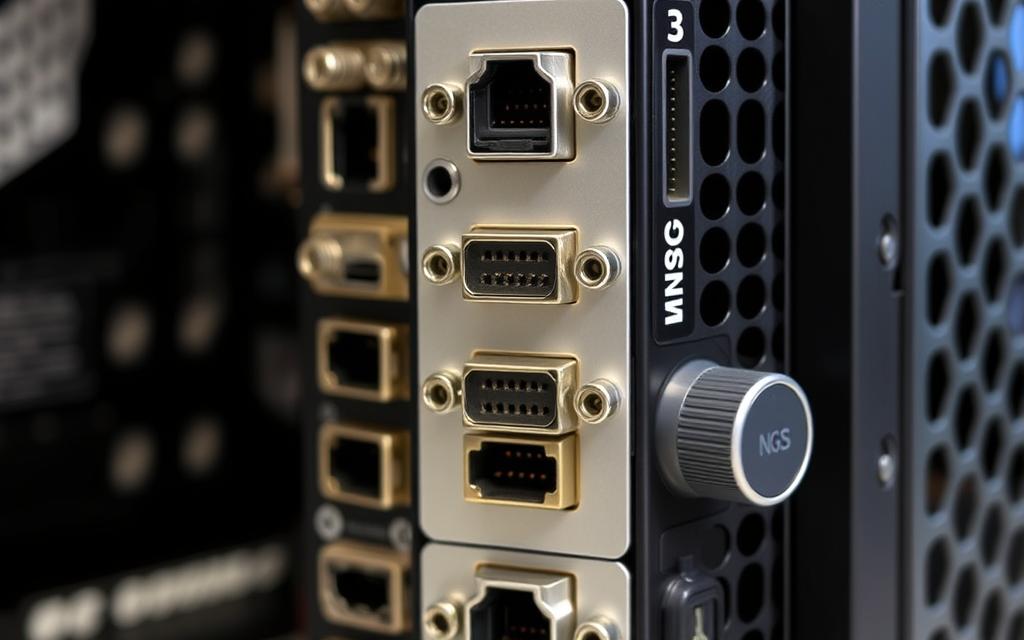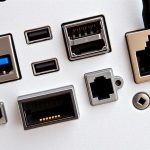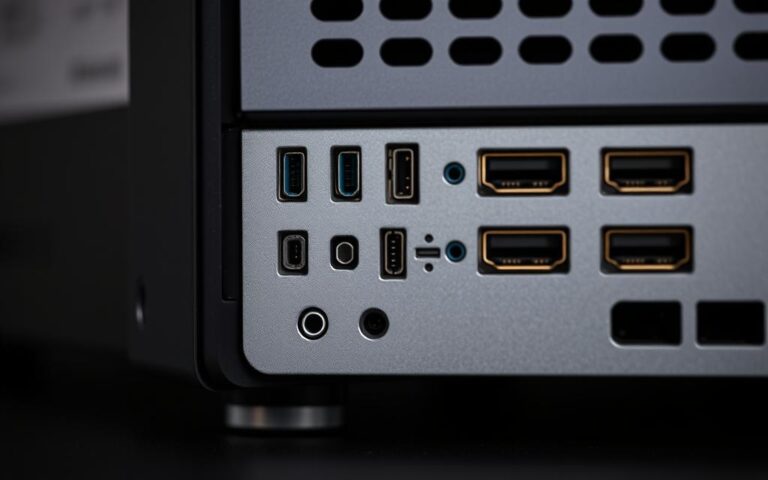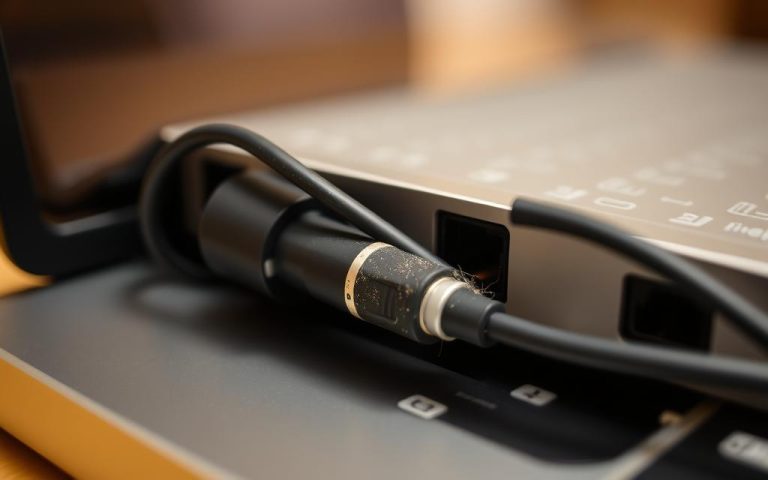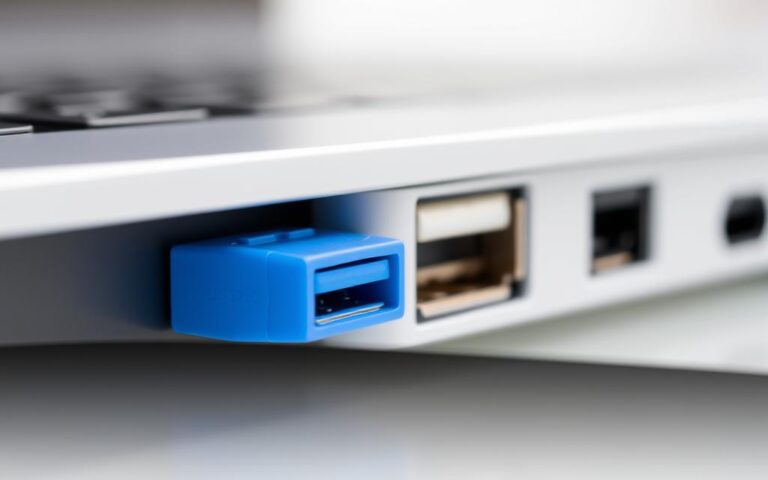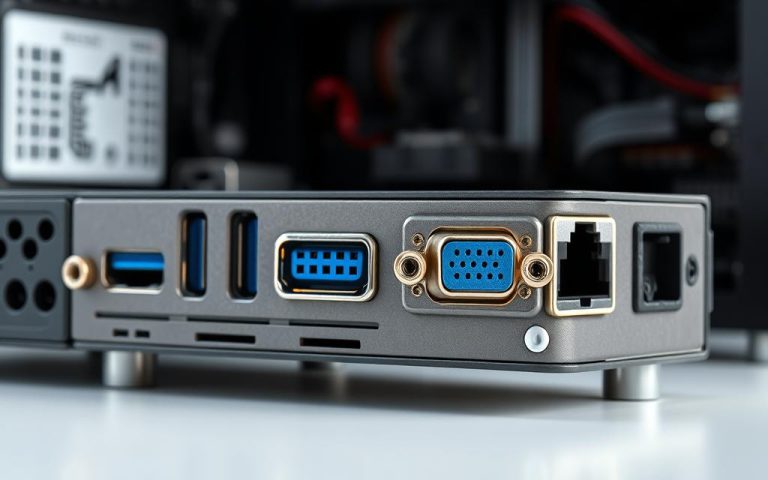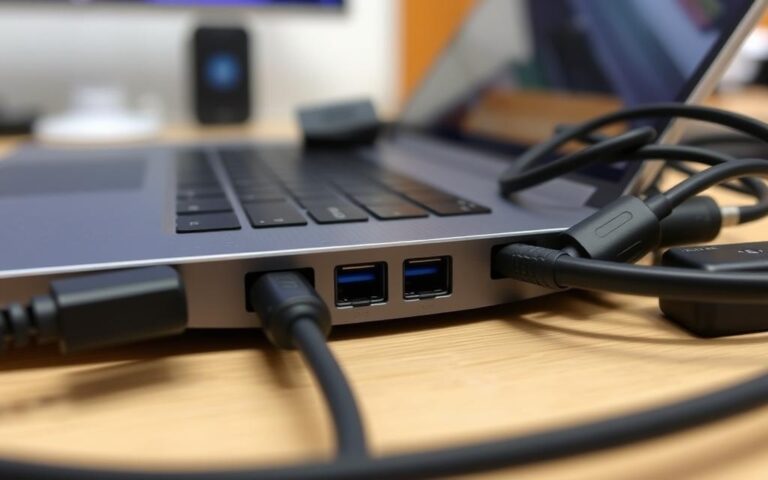Understanding the Number of COM Ports on a Computer
COM ports, also known as communication ports, are vital for serial communication and data transfer. Although newer technology has made traditional COM ports less common on new computers, they’re still crucial for connecting with different devices. This piece will explain what COM ports do, their key features, and why some computers have more ports than others. It will also show why they are still important in industries and systems that have been around for a while.
What are COM Ports?
A COM port, also known as a communication port, is a crucial input/output interface. It helps computers communicate with external devices. This is key for smooth data flow in many applications.
Definition and Functionality
COM ports are serial ports, meaning they send data one bit at a time. This approach is different from parallel communication, which sends bits all at once. Serial transfer is more reliable for short distances and needs fewer cables. Devices like printers, modems, and industrial machines often use COM ports to connect.
Importance of COM Ports in Data Transfer
The value of COM ports lies in their ability to provide simple yet reliable communication. They are perfect for settings that require low data rates but high signal integrity, like medical and industrial fields. Even as new technologies emerge, many older devices still rely on these ports. This highlights the ongoing benefits of serial communication. Learning about COM ports helps us understand how current systems work with older ones.
| COM Port | I/O Port | IRQ |
|---|---|---|
| COM1 | 0x3F8-0x3FF | 4 |
| COM2 | 0x2F8-0x2FF | 3 |
| COM3 | 0x3E8-0x3EF | 4 |
| COM4 | 0x2E8-0x2EF | 3 |
How Many COM Ports Does a Computer Have?
The number of COM ports a computer has varies a lot. It depends on the computer’s design and what it’s used for. While desktop and industrial computers usually have at least one serial port, laptops and smaller computers might not have any at all.
Typical Numbers on Modern Computers
Modern computers often keep one COM port. This is typically a serial port that meets RS-232 standards. In the past, computers had serial and parallel ports. Now, with USB connections, the need for many ports has reduced.
Factors Influencing the Number of COM Ports
What influences COM port numbers? It’s things like what the user needs and what’s popular on the market. Adding expansion cards can increase ports too. For old systems and industrial use, serial ports are still key. But, with the move towards USB, fewer old-school ports are built into new machines.
| Device Type | Typical Number of COM Ports | Common Ports |
|---|---|---|
| Desktop Computer | 1-2 | RS-232 |
| Laptop | 0-1 | RS-232 (via USB adapter) |
| Industrial PCs | 2-8 | RS-232, RS-422, RS-485 |
| Compact Models | 0 | USB-only |
This gives us a good look at how tech has changed. It shows us what kind of COM ports modern computers have and why.
Types of COM Ports
It’s key to know about different COM port connectors for good communication. Modern and old systems use them for data sharing. DB-9 and RJ-11 connectors are mainly used. They fit well in serial communications.
Common COM Port Connectors
The DB-9 connector has nine pins and is common for RS-232 serial communication. You can find it in computers and machines. The RJ-11 connector is mostly for phones. Yet, some cash registers use it too. Choosing the right connector depends on what you need it for.
Differences Between RS-232, RS-422, and RS-485
Different serial communication protocols suit different needs. RS-232 works for short distances, up to 15 metres, and one device. RS-422 is better for longer distances and faster speeds. It’s good for hard environments. RS-485 lets you connect many devices, up to 32, in a chain. It’s perfect for control systems that spread out.
- RS-232: Single device connection, up to 15 metres distance
- RS-422: Longer distances, higher speeds
- RS-485: Multiple device connections, up to 32 devices in one network
Knowing the difference helps pick the right protocol for your needs.
How Do COM Ports Work?
COM ports are important for data movement between your computer and other devices. They rely on serial communication, using specific pins. These pins have different roles in sending and receiving data.
Data Transmission Mechanism
Data moves from one point to another in bits through COM ports. It starts by converting data into bits. Then, it’s sent through pins like transmit (TX) and receive (RX). This makes sure data flows smoothly from one device to another.
The conversation between devices is clear thanks to this method. It’s key for tasks that need accurate signal transfers.
Understanding Pins and Signals
Knowing what each pin does is key to using COM ports well. For example, in a DB-9 setup, each pin has a special job.
| Pin Number | Functionality |
|---|---|
| 1 | Data Carrier Detect (DCD) |
| 2 | Receive Data (RX) |
| 3 | Transmit Data (TX) |
| 4 | Data Terminal Ready (DTR) |
| 5 | Signal Ground (GND) |
| 6 | Data Set Ready (DSR) |
| 7 | Request to Send (RTS) |
| 8 | Clear to Send (CTS) |
| 9 | Ring Indicator (RI) |
For COM ports to work right, understanding and using these signals properly is vital. With more devices needing to talk to each other, especially in automation, it’s crucial. Check out this link for more on pin roles.
Devices That Utilise COM Ports
Many devices need COM ports to work well, especially in industry. This is because they ensure reliable serial communication is possible. Knowing which devices use these ports shows how important they are in today’s tech world.
Examples of Serial Devices
Here are some devices that often use COM ports:
- Production Printers: These are high-volume printers. They use serial interfaces to move data quickly.
- CNC Machines: These machines need precise communication to operate perfectly.
- Medical Equipment: These are tools in healthcare that rely on COM ports for correct data gathering.
- Point-of-Sale Systems: Retail systems use serial connections to handle transactions and data smoothly.
- Automated Guided Vehicles (AGVs): These vehicles use serial protocols to improve how they move and navigate.
Importance in Industrial Automation and Legacy Systems
COM ports are vital in industrial automation. They let control systems talk to machines. This is key for tasks like welding and putting things together. Also, many older systems still need COM ports to work right. This keeps them useful in today’s tech setups.
The standards RS-232 and RS-485 show why serial communication is critical. RS-232 is good for short distances. RS-485 works for longer ones, fitting large industrial areas well.
Software Interaction with COM Ports
Working with COM ports is key for software and hardware devices talking to each other. Different programming languages help with this, making it easier to deal with serial communications. Python, C/C++, Java, and .NET are great choices. They have special libraries and tools for COM port programming. This makes creating software for different needs simpler.
Programming Languages Supporting COM Ports
Many programming languages can connect to COM ports. They come with their own set of tools and libraries. Here’s a short look at some of them:
| Programming Language | Libraries/Frameworks | Use Cases |
|---|---|---|
| Python | PySerial | Data logging, automation scripts |
| C/C++ | Windows API, Boost.Asio | Industrial applications, embedded systems |
| Java | Java Communications API | Cross-platform applications |
| .NET | System.IO.Ports | Windows applications, control systems |
Emulating COM Ports Using Software
Virtual COM ports are a game-changer for developers. They let you create fake serial ports for testing without real hardware. This is super useful for making sure applications work right with COM ports. It’s especially handy when the actual devices aren’t around.
Emulating COM ports through software brings a lot of perks. Testing in a safe environment and supporting old software are just a couple. It also gives developers more room to play during the coding phase.
- Testing applications in a controlled environment
- Supporting legacy software that interacts with COM ports
- Enhancing flexibility for developers during the programming process
Web systems can use virtual COM ports for working remotely. This lets them communicate over the internet or through serial tunneling. It means companies can keep using old gear while meeting new tech standards. For more on COM ports, have a look at this resource.

Limitations of COM Ports
Understanding COM port limitations is crucial for working with older systems and new applications. These ports have distance and speed limits. It’s important to see how they fare against newer technologies.
Distance and Data Rate Constraints
Distance constraints limit COM ports tremendously. The RS-232 protocol, for one, only supports data transmission up to about 15 metres at slow speeds. It’s not suitable for setups needing long cables. Alternatively, RS-422 and RS-485 offer better speeds and distances. Yet, they still can’t match the capabilities of newer technologies.
Comparing data rates of COM ports with newer interfaces shows big differences. COM ports do well for simple tasks. But they struggle with the demands of high-definition video and intricate audio setups.
Comparative Analysis with USB Ports
When comparing COM and USB ports, USBs come out on top. They transfer data faster and can handle many devices at once. This makes USBs better for applications needing smooth data sharing. COM ports have their place in certain industrial and legacy setups, where simplicity and reliability are key.
Even with new technologies, we shouldn’t overlook the role of COM ports. They are still valuable in industrial automation and legacy systems. Their straightforward, dependable connectivity matters.
In a world full of new standards, understanding our connectivity options is paramount. Knowing COM port limitations helps choose the right interface for different uses and settings. Read more about connectivity options at this link.
Conclusion
COM ports may not be common in new tech, but they’re crucial in areas like industrial automation. When we delve into serial communication standards like RS-232, RS-422, and RS-485, we see their key role. They’re essential for sending data effectively, showing why COM ports still matter.
Looking at COM ports’ features and limits tells us a lot. With speeds up to 115,000 baud for RS-232 and RS-485’s ability to link many devices over great distances, they’re quite useful. Even as technology moves forward, COM ports adapt, keeping their place in the mix of old and new.
Understanding COM ports means making smarter tech choices today. They have their unique strengths and uses, underlining their value in communication tech’s ongoing story. This keeps them critical in our ever-changing tech world.
FAQ
What are COM ports and how do they function?
A: COM ports, or communication ports, are interfaces on a computer. They manage serial communication with external devices like printers. Each bit of data transfers one at a time, ensuring solid connections.
How many COM ports are typically found on modern computers?
Modern computers can vary in the number of COM ports they have. Desktops often have at least one RS-232 interface. But, many laptops need a USB-to-serial adapter to connect with older devices.
What factors influence the number of COM ports available on a computer?
The main factors include the computer’s use, whether for industrial or personal tasks. Also, available expansion cards, and the trend towards USB matter. Manufacturers are now choosing USB over older options.
What are some common connectors associated with COM ports?
For COM ports, the typical connectors are DB-9 and DB-25. These fit various serial communication needs. Meanwhile, RJ-11 connectors are found in systems like point-of-sale.
What type of protocols are used with COM ports?
RS-232 is a common protocol for short distances, up to 15 metres. RS-422 and RS-485 support longer distances and more devices. RS-485 even allows up to 32 devices in a chain.
How is data transmitted through COM ports?
Data sends as bits through pins, specifically transmit (TX), receive (RX), and ground (GND) pins. This direct method keeps data clear and consistent, vital for many applications.
Which devices typically utilise COM ports?
Many devices need COM ports. Including printers, 3D printers, and CNC machines. They rely on these ports for smooth operation.
What programming languages can interact with COM ports?
Languages like Python, C/C++, Java, and .NET work with COM ports. They have libraries to make programming COM port interactions easier. This is key for programming in certain fields.
Can COM ports be emulated using software?
Yes, software now can mimic COM ports. This creates virtual serial ports on computers. It’s useful for application testing and supporting old software without needing hardware.
What are the limitations associated with COM ports?
COM ports have limits, such as short distance (under 15 metres) and slower data rates. Also, they connect fewer devices compared to USB ports.
How do COM ports compare to USB ports in modern use?
Though reliable for certain uses, COM ports lag behind USB in speed and ease of use. USB’s wider compatibility and faster speeds make it more suitable for many applications.

